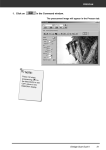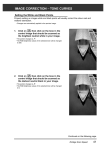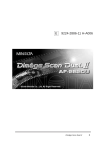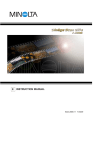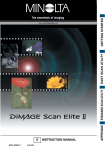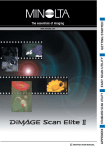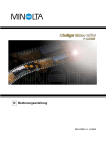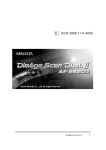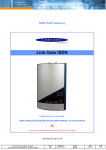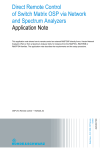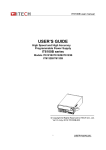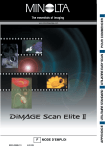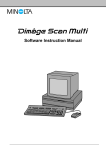Download Minolta Dimage Scan Elite Film Scanner
Transcript
IMAGE CORRECTION — BRIGHTNESS/CONTRAST/COLOR BALANCE 1. Drag each Brightness, Contrast or Color balance slider or input the desired value in the text box. • The change will be reflected in the preview image. • Moving the Brightness, Contrast or Color balance slider changes “PostCorrection Gray Scale” and “Post-Correction LUT”. Post-Correction LUT The color of the image is changed as shown in the PostCorrection LUT. The correspondence between the color displayed on the PreCorrection Gray Scale and Post-Correction Gray Scale appears on the Post-Correction LUT. Auto setting When the Auto setting button is clicked, the brightness and contrast of the image is corrected automatically according to the lightness without changing the color balance. 41 IMAGE CORRECTION — HUE/SATURATION/LIGHTNESS When the Hue/Saturation/Lightness Correction button is clicked, the Hue/Saturation/Lightness Correction window is displayed. The images can be corrected by dragging the slider or inputting the desired value in the text box. • Click on in the Image Correction window. The Hue, Saturation, Lightness Correction Dialog box — Name of parts Hue-level slider Hue-level text box Saturation slider Brightness text box Lightness slider Saturation text box Pre-Correction Color Sample Lightness text box Post-Correction Color Sample 1. Drag the each Hue, Saturation or Lightness slider or input the desired value in the text box. • The change will be reflected in the preview image. • To change the colour, move the Hue, Saturation or Lightness slider (or input the desired value in the text box). • Moving the slider changes “Pre-Correction Color Sample” and “Post-Correction Color Sample”. Pre-Correction Color Sample and Post-Correction Color Sample The colour of the image is changed as shown in “Correction Color Sample”. The colour displayed in “Pre-Correction Color Sample” is changed as shown in “Post-Correction Color Sample”. 42 IMAGE CORRECTION — HUE/SATURATION/LIGHTNESS Auto setting When the Auto setting button is clicked, the saturation of the image is corrected automatically without changing the hue and lightness. Reset If you click the Reset button, the settings in the current correction window are reset. 43 IMAGE CORRECTION – VARIATION CORRECTION The variation frames are displayed around the corrected preview image. You can correct the image while comparing with the variation images. 1. Click on in the Image Correction window. The Variations Dialog Box — Names of Parts Variation Amount Control slider Correction list box Pre/Post Correction Image Display Area Variation Amount Control text box Limit Indication check box Selecting the Correction Item You can select from colour balance, brightness, contrast and saturation as the correction item to be used in the variation correction. However, colour balance and saturation are not available when using monochrome film. 1. Click on the arrow next to the correction item in the correction list box. The available correction items are displayed. 2. Click the correction item. • The variation frames are corrected according to the selected correction item. 44 IMAGE CORRECTION — VARIATION CORRECTION Color Balance Correction The 6 images that have been corrected by one-step in each RGBCMY direction for the center image are displayed. 1. Click the colour balance. • The corrected 6 frames of variation images are displayed. 2. Click the image in the direction you want to correct from the 6 frames of the variation images except for the center image. • The image you clicked is placed in thw centre and 6 new variation images that have been corrected by one-step in each direction are displayed. 3. Correct the image by repeating the operation in step 2. Brightness & Contrast Correction The 8 images of which brightness and contrast have been corrected by one-step in horizontal and vertical direction respectively for the center image are displayed. The variation images on the left and lower sides of the center image show the – correction effect, and on the right and upper sides of the center image show the + correction effect. 1. Click the image in the direction you want to correct from the 8 frames of the variation images except for the center image. • The image you clicked is placed in the centre and 8 new frames of the preview images that have been corrected in each direction are displayed. 2. Correct the image by repeating the operation in step 1. 45 IMAGE CORRECTION — VARIATION CORRECTION Saturation Correction The 2 images of which saturation has been corrected on the right and left sides of the center image are displayed . The variation image on the left side shows lower effect, and on the right side shows higher effect. 1. Click the image in the direction you want to correct from the 2 frames of the images except for the image in center. • The image you clicked is placed in the centre and 2 new frames of the variation images that have been corrected are displayed. 2. Correct the image by repeating the operation in step 1. Changing the Amount of Correction Step The amount of correction step can be changed by moving the Variation Amount Control slider. The desired amount can be also input in the text box. 46 IMAGE CORRECTION — SNAPSHOT When the Snapshot button is clicked, the current preview image is stored in the Snapshot Display Area temporarily and displayed as a thumbnail. When the thumbnail in the Snapshot Display Area is double-clicked, that image is displayed in the preview window. This allows a number of varying different corrections to be made and then compared without having to go back and retrace previous correction steps. Storing in the Snapshot Display Area temporarily 1. Click on . • The displayed preview image is displayed in the Snapshot Display Area as a temporary storing place. Snapshot Display Area 1 Displaying the image stored temporarily as a preview image 1. Click on the thumbnail in the Snapshot Display Area. • The displayed preview image is deleted and the thumbnail image is displayed as a preview image. Snapshot Display Area 2 47 Full-Screen View This function allows you to display full screen the view of the corrected image in the image correction window. 1. Click the Full-Screen View button. • When the Pre/Post Correction Image Comparing Display button is clicked, the size of the pre and post correction image is automatically changed according to the size of the main window. Checking the Correction Result While Lining Up Images When the Pre/Post Correction Comparison Display button is clicked, the image correction windows are divided into right and left sides and pre-correction images are displayed in the left side, and post-correction images are displayed in the right side. 48 IMAGE CORRECTION — JOB SAVE/JOB LOAD The image correction setting in each correction window can be saved as an image correction job. You can easily correct the image by loading the apporopriate correction job. Saving Image Correction Job 1. Click on the Image Correction Job Save button in the Image correction tab. • The Register Image Correction job dialog box is displayed. 2. Input the job name and click on the OK button. • The current image correction setting is saved as an image correction job. 49 IMAGE CORRECTION — JOB SAVE/JOB LOAD Loading Image Correction Job This function allows you to load the saved correction job and apply an image correction to the displayed image. 1. Click on the Image Correction Job Load button in the correction window. • The Image Correction Job List window is displayed. Image Correction job display area Original image display 2. Select the image correction job and click on the OK button. Canceling the Image Correction When the Undo button is clicked, the current image correction is canceled and the image returns to the previous one. Redo the Correction When the Redo button is clicked, the canceled image correction can be resumed. Delete the Image Correction When the Undo Correction button is clicked, all image correction is deleted and the image returns to the initial state. 50 NAVIGATION The Navigation window allows you to automat the procedure of scanning. When the Navigation button is clicked in the Main window, the navigation window is displayed. The Navigation Dialog box — Name of parts Operation Item checkbox Navigation Menu list box Navigation Flow Operation Items APS Repeated Operation Item checkbox Navigation Start button Navigation Stop button 51 NAVIGATION Navigation Menu This menu allows you to select the saved setting for automatic operation. Not only the saved settings but the “Save Setting” and “Delete Setting” items are displayed in this menu. 1. Select the operation items in the Operation Item Checkbox or APS Repeated Operation Item checkbox. • The selected items are displayed with the buttons and arrows as a Navigation Flow. 2. Click the Navigation Start button. • To stop, click the Navigation Stop button. Operation item checkbox Insert the check mark in the operation items to be performed as the automatic operation. When using a film format other than APS, the index scan, film frame selection and rewind cannot be selected. 1. Insert the check mark in the operation items to be performed as the automatic operation. APS repeated operation item checkbox Insert the check mark in the items to be performed for all frames of the images every time you execute the automatic operation. When using a film format other than APS, the APS Repeated Operation Item checkbox cannot be selected. 1. Insert the check mark in the operation items to be performed for all frames of the images every time you execute the automatic operation. Operation items The operation items in the automatic operation are displayed. 1. Select the details of the operation items with the radio button or checkbox. 52 NAVIGATION Saving, Selecting and Deleting a Navigation Setting This function allows you to save the navigation settings. The above settings can be saved, selected or deleted in the Navigation Menu list box. Saving a Navigation setting 1. Click on the arrow next to the Navigation menu list to display the available menu. 2. Select saving setting. • The Navigation set saving dialog box is displayed. 3. Input the setting name and click the OK button. Selecting a Navigation setting 1. Click on the arrow next to the Navigation menu list to display the available menu. 2. Select the setting to be used. Deleting a Navigation setting 1. Click on the arrow next to the Navigation menu list to display the available menu. 2. Select the setting to be deleted. • The Navigation set deleting dialog box is displayed. 3. Select the setting to be deleted and click the Delete button. 53 FINAL SCAN Scan the film according to the Preview settings. With the Dimâge Scan Elite utility software, you can save the final scan in one of the following file formats. JPEG TIFF BMP (Windows only) PICT (Macintosh operating system only) The 48 bit (16 bit each RGB) image file can be saved in the tiff format only. Twain Driver Plug-in Software With the Preview image displayed in the Preview window. 1. Click on in the Main window. • The final scan will begin. • When scanning is complete, the final scan will appear in the host application. 2. Save the image using the instructions for your host application. 3. Close the Control Window to exit the Dimâge Scan Elite driver software. • The driver window will close automatically after each scan if the Close Driver After Scanning option was selected in the Preferences dialog box (p. 21). Utility Software With the Prescan image displayed in the Preview window. 1. Click on in the Main window. Your system’s standard save dialog box will appear. 2. Enter the desired file name and select the file destination. 3. Select the file type from the drop-down list. 4. Click on . • The final scan will begin. • When scanning is complete, the scan will be saved in the selected location. The software will return to the Preview window. 5. Close the Control Window to exit the Dimâge Scan Elite driver software. • The driver window will close automatically after each scan if the Close Driver After Scanning option was selected in the Preferences dialog box (p. 21). 54 SCANNING APS FILM SCAN FLOW Launch Software Specify the Film Type Set Preferences Load and Insert the Film Holder Index Scan Select Frame(s) to Prescan from Index Print OR Select Frame(s) to Prescan Prescan Orient and Crop Correct the Contrast, Brightness and Color Specify the Job Type Scan Save LAUNCH SOFTWARE SPECIFY FILM TYPE 1. Launch the software (pp. 18-19). 2. Select APS Cassette from the film format dropdown list in the main window. 3. Select the film type from the film type drop-down list. 56 PREFERENCES – APS SETTINGS 1. Click on in the Main window. The preferences dialog is displayed. 2. Set the Preferences as desired in the APS settings part. • De-select the Close Driver Software After Scanning check box when scanning multiple images at the same time. Index Scan Priority Speed – Creates a thumbnail representation of each frame on the roll. Quality – Thumbnail and Preview images are created for each frame on the roll. • Double-clicking on the index image opens the ready-made preview image. Auto Film Rewind Clicking on the eject button in the Command window automatically rewinds the film into the APS cassette before the APS adapter is ejected. Rotate All Frames 180° Rotates all frames in the index window 180°. 57 APS ADAPTER (OPTIONAL) The AD-10 APS Adapter is an optional accessory. The Dimâge Scan Elite can not scan Advanced Photo System film (IX-240 type) without the AD-10 APS Adapter. Names of Parts Film-chamber door Film-chamber release Scanner contacts* * Do not touch Loading the APS Adapter 1. Slide the film-chamber release as shown. • The film-chamber door will open. 2. Insert the film cassette into the film chamber with the VEI (Visual Exposure Indicator) on top. 3. Close the film-chamber door. • The film-chamber door will not close if the mark is not highlighted. Forcing the door shut could damage the cassette. 58 APS ADAPTER (OPTIONAL) Inserting the APS Adapter 1. Press the door where shown to unlock, …then open the scanner’s film door. 2. Insert the APS Adapter into the scanner. 59 INDEX SCAN Index scan displays a scan of each image on the cassette in the index scan window. The time required for an index scan depends on the performance of your machine. If you don’t want to index scan the entire roll, select the frame number of the image you want to scan from the index print provided by your photofinisher. Click on the appropriate image box in the index window to select an image for prescanning or scanning. • There are two options for making an index scan, Speed or Quality. Select the desired option in the Preference dialog box (p. 57). Index Window – Names of Parts Reverse frame order button Frame number Rotate left button Index Image frame Rotate right button Image Correction Job Load button Flip Horizontal button Flip Vertical button Index Load button Full-Screen View button Save Index Scan button Index imag 60 INDEX SCAN Index scan Click on in the Main window. • All frames on the cassette will be scanned and appear in the Index window. Click on to reverse the display order. • To cancel th e index scan, press the escape key ( -• Command and period for the Macintosh) un til the Cancelling In dex Scan mes sage box appears. • The complet ed index scan s will appear in the index window. • Frames that have not been index scanned can still be select ed for prescanning and scanning . 61 INDEX SCAN Index scan Change the size of the Index scan window as desired. The position of the frames will change accordingly. Click on the corner tab and drag to reach the desired size. • When the Full-Screen View button is not clicked, the size and shape of the index frames does not change. • When the Full-Screen View button is clicked, the size of the index frames changes automatically and all frames are displayed. Rotating the Index Frames Rotate index frames so they appear in the index scan window with the proper orientation. Select the desired frames, then click on , • The selected frames will rotate in 90° increments either clockwise or counter-clockwise or flip vertically or horizontally. • Rotating the index frame will not affect the Preview or Scan. 62 or , . PREVIEW AND IMAGE CORRECTION 1. Click on an image or an image box, then click on prescanned, then opened in the Preview window. Click here to specify an APS format (C, H, or P) cropping frame. 2. Orient and crop the image as desired (pp. 29-33). 3. Apply contrast, brightness, and colour corrections (pp. 34-46). 4. Select the desired job type (pp.71-72). • Only one job type can be selected when multiple images are scanned at the same time. 5. Close the Preview window to return to the Index window. • Adjustments made in the Preview window are held until the image is scanned or the driver software is closed. 63 . The image will be SCANNING THE IMAGE Selecting Frames 1. Click on an image to select it for scanning. • Selected images are surrounded by a dark gray frame. • Press the control key ( key for the Macintosh) while clicking to select additional frames for scanning. • Press the control key ( key for the Macintosh) while clicking to deselect an image. CLICK CLICK CLICK CLICK • Press the shift key while clicking to select all the frames between the current frame and the last frame selected. 2. Click on image(s). to scan the selected • The scan is cancelled if more than the number of frames selected is greater than the Max # of Frames set in the Preferences dialog box. See Preferences - APS Settings on page 57. • The image will be opened in your photo application software when the scanner’s driver software is closed. • Some photo applications can only acquire one image at a time. 3. Refer to page 54 to save the scanned image(s). • Multiple scans will be saved using the selected file name and numbered chronologically. Example: File_Name01, File_Name02, File_Name03... 64 Click on to save the index as an im age file. • The image can be saved in JPEG or BMP format (JPEG or PIC T format for th e Macintosh). REMOVING THE APS ADAPTER 1. Click on to rewind the film into the cassette. • This step is not necessary when the auto rewind option is selected in the Preference dialog box window (p. 49). 2. Remove the APS adapter from the scanner and close the film door. 3. Close the Control Window to exit the Dimâge Scan Elite driver software. • The driver window will close automatically after each scan if the Close Application After Scanning option was selected in the Preferences dialog box (p.21). 4. Open the APS adapter’s film chamber door and remove the cassette. 65 Multiple imag es can be scanned befo re closing the software. • Some photo applications can only acqu ire one image at a tim e. 66 APPENDIX COLOR MATCHING This function allows you to match the scanner data to the monitor type (colour space). The output colour space and ICC profile can be specified by using the colour matching function. To match the scanner data to the colour space, specify the output colour space. To correct the color reproduction character of the monitor and to reduce the difference of color between monitors in different environments in addition to the color space setting, specify the monitor ICC profile settings in both the driver software and a software such as Photoshop. For details, refer to page 69. 1. Click on in the Main window. The Color Matching in the Preference Dialog Box — Name of parts Color Matching ON checkbox ICC profile setting checkbox ICC profile text box Output Color Space list box ICC profile Load button 2. Set the preferences as desired. • De-select the Close Driver After Scanning check box when scanning multiple images at the same time. 68 When the colo r matching func tion is used, the processing tim e may be longer . COLOR MATCHING Output colour space setting 1. Insert the check mark in the “Color Matching ON” box. 2. Click the (menu) button in the output colour space list box, the available output colour space settings are displayed. 3. Click the desired output colour space setting. ICC profile setting 1. Insert the check mark in the “use ICC profile” box. 2. Click the Load button. • The standard file open dialog of your operating system is displayed. 3. Select the ICC profile according to the monitor being used. The application may perform the original matching process. If you want to change the setting, refer to the following sample settings. When the colour matching function is used, the colour matching function of the OS, video card, etc. are disabled. When using Photoshop Ver.3.0.5 or Ver. 4.0.1 Output colour space: ICC profile*1): Apple RGB select (for Windows) This is not used (for Macintosh) When using an application of which the monitor colour matching function is set to ON Output colour space*2): ICC profile*1): option select When using an application of which the monitor colour matching function is set to OFF, or when using an application which does not have the monitor colour matching function. Output colour space: do not specify select ICC profile*1): When an image is scanned with this setting, the data is matched according to the monitor being used. *1) ICC profile specifies the ICC profile of the monitor. *2) The same color space as specified in the application is specified. 69 SCAN SETTINGS The scan settings determine your final image’s resolution, dimensions, and file size, as well as helping determine the image quality. You can select a Job (p. 71) to have the scan settings selected for you or you can directly enter them into the Main window (Index window or Preview window). The Scan Settings part in the Main Window — Names of parts Except the Image Correction window in the Main window. Job Name list box Units list box Input Resolution list box Image size display Output Resolution list box Job Load button Input Size text box (W) Job Registry button Input Size text box (H) Input Size lock button Magnification text box Output Size lock button Output Size text box (W) Reset button Output Size text box (H) 70 SCAN SETTINGS Image resolution is the number of pixels per inch (ppi or dpi) that represent your scanned image. The size of an image file is determined by its size (dimensions) and resolution. The rule to follow when scanning is "bigger is better". To obtain the best results, set the output resolution to the highest value your final output device (printer, monitor, etc.) can handle. The driver software automatically determines the input resolution necessary to obtain the desired output size and resolution. 1. Click on in the Index window. The Job Selection dialog box will appear. 2. Select the appropriate category from the drop-down list. 3. Click on the job file name to select it, then click on . • The settings are applied to the active Preview window. Job names ca n be listed chronologically or Select the form alphabetically. at by clicking on the Name or Date option bu tton. • The cropping frame change s accordingly, bu t can be propor tionally resized. Continued on the following page. 71 SCAN SETTINGS 4. Enter the desired output resolution from the output resolution drop-down list. • Values can also be entered into the output resolution list box directly. • The output resolution cannot be changed when the unit list box is set to pixels. 5. The dimensions of the cropping frame are displayed in the input size text boxes. • Values can be entered directly or by resizing the cropping frame. • The values will change if a different unit of measure is selected. • The scanning area size can't be changed if the Input Size is locked. 6. Enter the desired output size (maximum 3 digits). • The output size is limited by the maximum resolution of the scanner. • The values will change if a different unit of measure is selected. • The output size cannot be changed when the unit list box is set to pixels. • The scanning area size can be changed proportionally (within the resolution limits) when the Output Size is locked. • Click on to lock the se ttings. The icon will change to . Click again to unlock. • The magnific ation text box displays the ou tput/input size ratio as a perc entage. • Magnificatio n values can be entered direct ly. 7. The input scan resolution text box is set to the lowest input (scan) resolution necessary to achieve the desired output size and resolution. • Input scan resolutions can also be selected from the drop down list or entered directly. 72 CREATING / DELETING JOB FILES Creating a Job In addition to the Job settings included with the software, it is possible to create and save your own Job settings. 1. Set the desired settings in the Main window (Index window or Preview window). 2. Click on . The Job Registry dialog box will appear 3. Name the job by entering a title and select the desired category, then click on . Deleting a Job It is possible to delete the Job you created when it is no longer needed. Click on the name of the job in the Main window scan settings part, then press the delete key on your keyboard. 73 SCAN JOB TYPE Before making the final scan, the scanner needs to know how big the final image will be and the quality of output that will be used (printer, monitor, etc.) so it knows what resolution to scan the film. Using the Job function is a quick and easy way to enter the scan settings. Scan Job Category Description Custom User created scan settings (p. 71). Color Laser Printer Digital colour copiers and colour laser printers Uses output resolution of 400 or 600 dpi. There are two paper-size options; letter and A4. Photosensitive Printers that use photosensitive/photographic material Can use output resolutions of 400 dpi, 360 dpi, 267 dpi, and 180 dpi. There are ten paper size options. Dye-Sub Printer Dye-sublimation printers Uses an output resolution of 300 dpi. There are 4 paper size options. Ink Jet Printer Uses an output resolution of 200 dpi. There are 4 paper size options. Web Page For use on home pages Image size is listed in pixels and will vary. Standard Photo CD sizes are also available. Screen For monitor display Image size is listed in pixels and will be the VGA standard of 640 x 480 pixels or larger. Document For insertion into documents Uses an output resolution of 72 dpi. Image size depends on the paper size selected. Film Recorder Default For high input resolution images that will be output to a film recorder. This category uses the default settings for the film format. The scan settings appear in the Job Selection window. 74 SCAN JOB FILE LIST – 35MM For your reference, the following is a listing of the scan job categories and names for the 35mm and APS film formats. Category Job name Default Default Color Laser Printer Max Size_600dpi Photosensitive Dye-Sub Printer Ink-Jet Printer A4Quarter_600dpi A4Eighth_600dpi Letter Quarter_600dpi Letter Eighth_600dpi Max Size_400dpi A4Half_400dpi A4Quarter_400dpi A4Eighth_400dpi Letter Half_400dpi Letter Quarter_400dpi Letter Eighth_400dpi Max Size A5_400dpi 8x10_400dpi 5x7_400dpi PostCard4 6_400dpi Letter_267dpi A4_267dpi A5_267dpi 8x10_267dpi 5x7_267dpi PostCard4 6_267dpi (unavailable) 2L_360dpi 14x17_180dpi 11x14_180dpi 10x12_180dpi (unavailable) 2L_180dpi A4Full A4Half A4Quarter A4Eighth Letter Full Letter Half Letter Quarter Letter Eighth (unavailable) Photo4x6 Photo3x5 /Photo9x13 A4Full A4Half A4Quarter A4Eighth Letter Full Letter Half Letter Quarter Letter Eighth (unavailable) Photo4x6 Photo3x5 /Photo9x13 Resolution In Out 705 2820 2447 1735 2291 1702 2820 2313 1629 1156 2291 1526 1133 2820 2313 2798 1961 1678 2039 2187 1545 1870 1307 1120 1597 1727 2123 1747 1494 797 857 2455 1735 1223 866 2291 1714 1144 850 1223 1240 1049 163 1156 814 577 1526 1144 763 566 814 826 699 300 600 600 600 600 600 400 400 400 400 400 400 400 400 400 400 400 400 267 267 267 267 267 267 360 360 180 180 180 180 180 300 300 300 300 300 300 300 300 300 300 300 200 200 200 200 200 200 200 200 200 200 200 Mag. Unit Input Size W H 235 470 407 289 381 283 705 578 407 289 572 381 283 705 578 699 490 419 763 819 578 700 489 419 443 479 1179 970 830 442 476 818 578 407 289 763 571 381 283 407 413 349 818 578 407 288 763 572 381 283 407 413 349 pixel mm mm mm inch inch mm mm mm mm inch inch inch mm mm inch inch inch inch mm mm inch inch inch mm mm mm mm mm mm mm mm mm mm mm inch inch inch inch mm mm mm mm mm mm mm inch inch inch inch mm mm mm 1008 36.3 36.3 36.3 1.43 1.43 36.3 36.3 36.3 36.3 1.42 1.43 1.43 36.3 36.3 1.43 1.43 1.43 1.43 36.3 36.3 1.43 1.43 1.43 36.3 36.3 36.3 36.3 36.3 36.3 36.3 36.3 36.3 36.3 36.3 1.43 1.43 1.43 1.43 36.3 36.3 36.3 36.3 36.3 36.3 36.4 1.42 1.42 1.43 1.43 36.3 36.3 36.3 672 24.2 24.2 24.2 0.95 0.95 24.2 24.2 24.2 24.2 0.95 0.95 0.95 24.2 24.2 0.95 0.95 0.95 0.95 24.2 24.2 0.95 0.95 0.95 24.2 24.2 24.2 24.2 24.2 24.2 24.2 24.2 24.2 24.2 24.2 0.95 0.95 0.95 0.95 24.2 24.2 24.2 24.2 24.2 24.2 24.3 0.95 0.95 0.95 0.95 24.2 24.2 24.0 Input Lock OFF OFF OFF OFF OFF OFF OFF OFF OFF OFF OFF OFF OFF OFF OFF OFF OFF OFF OFF OFF OFF OFF OFF OFF OFF OFF OFF OFF OFF OFF OFF OFF OFF OFF OFF OFF OFF OFF OFF OFF OFF OFF OFF OFF OFF OFF OFF OFF OFF OFF OFF OFF OFF Output Size W H 1008 170.00 148.00 105.00 5.46 4.05 256.00 210.00 147.00 105.00 8.19 5.45 4.05 256.00 210.00 10.00 7.01 6.00 10.90 297.00 210.00 10.00 7.00 6.00 161.00 174.00 428.00 352.00 301.00 160.00 173.00 297.00 210.00 148.00 104.00 10.90 8.17 5.45 4.05 148.00 150.00 127.00 297.00 210.00 148.00 105.00 10.90 8.17 5.45 4.05 148.00 150.00 127.00 672 113.00 98.70 70.00 3.64 2.70 170.00 140.00 98.00 69.90 5.46 3.63 2.70 170.00 140.00 6.66 4.67 4.00 7.27 198.00 140.00 6.67 4.66 4.00 107.00 116.00 285.00 235.00 200.00 106.00 115.00 198.00 140.00 98.70 69.90 7.28 5.44 3.63 2.70 98.70 100.00 84.60 198.00 139.00 98.50 69.80 7.27 5.45 3.63 2.70 98.50 100.00 84.50 Output Lock OFF ON ON ON ON ON ON ON ON ON ON ON ON ON ON ON ON ON ON ON ON ON ON ON ON ON ON ON ON ON ON ON ON ON ON ON ON ON ON ON ON ON ON ON ON ON ON ON ON ON ON ON ON Continued on the following page. 75 SCAN JOB FILE LIST – 35MM Category Web Page Screen Document Film Recorder Job Name 1023 x 682 960 x 640 870 x 580 768 x 512 624 x 416 600 x 400 480 x 320 Photo CD 2048 x 3072 Photo CD 1024 x 1536 Photo CD512 x 768 Photo CD256 x 348 1280 x 1024 1280 x 960 1152 x 870 1024 x 768 832 x 624 800 x 600 640 x 480 A4 Half A4 Quarter A4 Eighth Letter Half Letter Quarter Letter Eighth 35mm Full-Frame 35mm Half-Frame 35mm Quarter-Frame Resolution In Out 716 671 608 537 436 419 335 2148 1074 537 243 895 895 805 716 582 559 47 416 293 207 411 274 203 2382 1586 1189 300 300 300 300 300 300 300 300 300 300 300 300 300 300 300 300 300 300 72 72 72 72 72 72 2400 2400 2400 Mag. Unit Input Size W H 238 223 202 179 145 139 111 716 358 179 81 298 298 268 238 194 186 149 577 406 287 570 379 281 99 66 49 pixel pixel pixel pixel pixel pixel pixel pixel pixel pixel pixel pixel pixel pixel pixel pixel pixel pixel mm mm mm inch inch inch mm mm mm 1023 960 870 768 624 600 480 3072 1536 768 348 1280 1280 1152 1024 832 800 640 36.3 36.4 36.4 1.43 1.43 1.44 36.30 36.30 36.7 76 682 640 580 512 416 400 320 2048 1024 512 232 853 853 768 682 554 533 426 24.2 24.1 24.3 0.95 0.95 0.96 24.20 24.20 24.40 Input Lock OFF OFF OFF OFF OFF OFF OFF OFF OFF OFF OFF OFF OFF OFF OFF OFF OFF OFF OFF OFF OFF OFF OFF OFF OFF OFF OFF Output Size W H 1023 960 870 768 624 600 480 3072 1536 768 348 1280 1280 1152 1024 832 800 640 210.00 148.00 105.00 8.16 5.44 4.04 36.00 24.00 18.00 682 640 580 512 416 400 320 2048 1024 512 232 853 853 768 682 554 533 426 139.00 98.40 70.00 5.44 3.62 2.69 24.00 16.00 11.90 Output Lock ON ON ON ON ON ON ON ON ON ON ON ON ON ON ON ON ON ON ON ON ON ON ON ON ON ON ON SCAN JOB FILE LIST – APS Category Job name Default Default Color Laser Printer Max Size_600dpi Photosensitive Dye-Sub Printer Ink-Jet Printer Web Page Screen Document A4 Eighth_600dpi Letter Eighth_600dpi Max Size_400dpi A4 Half_400dpi A4 Quarter_400dpi A4 Eighth_400dpi Letter Quarter_400dpi Letter Eighth_400dpi Max Size A5_400dpi 5x7_400dpi Post Card 4 x 6_400dpi Letter_267dpi A4_267dpi A5_267dpi 8x10_267dpi 5x7_267dpi PostCard4 x 6_267dpi (unavailable) 2L_360dpi 14x17_180dpi 11x14_180dpi 10x12_180dpi (unavailable) 2L_180dpi Max Size A4 Half A4 Quarter A4 Eighth Letter Full Letter Half Letter Quarter Letter Eighth (unavailable) Photo 9x13 A4 Full A4 Half A4 Quarter A4 Eighth Letter Full Letter Half Letter Quarter Letter Eighth Photo 4 x 6 Photo 3.5 x 5/Photo 9 x 13 1280 x 739 1152 x 665 1024 x 590 832 x 480 800 x 461 640 x 369 Photo CD1024 x 1536 Photo CD512 x 768 Photo CD256 x 348 1280 x 1024 1280 x 960 1152 x 870 1024 x 768 832 x 624 800 x 600 640 x 480 A4 Half A4 Quarter A4 Eighth Letter Half Resolution In Out 705 2820 2104 2161 2820 2809 1977 1401 1851 1440 2820 2809 2374 2039 2472 2654 1870 2263 1586 1359 1935 2092 2578 2117 1809 966 1046 2820 2104 1482 1050 2776 2161 1385 1080 1500 1270 1977 1401 987 700 1846 1440 924 720 1001 846 1085 976 867 705 678 542 1303 650 294 1085 1085 976 867 705 678 542 504 355 251 518 300 600 600 600 400 400 400 400 400 400 400 400 400 400 267 267 267 267 267 267 360 360 180 180 180 180 180 300 300 300 300 300 300 300 300 300 300 200 200 200 200 200 200 200 200 200 200 300 300 300 300 300 300 300 300 300 300 300 300 300 300 300 300 72 72 72 72 Mag. Unit 235 470 350 360 705 702 494 350 462 360 705 702 593 509 925 994 700 847 594 508 537 581 1432 1176 1005 536 581 940 701 494 350 925 720 461 360 500 423 988 700 493 350 923 720 462 360 500 423 361 665 239 235 226 180 434 216 98 361 361 325 289 235 226 369 700 493 348 719 pixel mm mm inch mm mm mm mm inch inch mm mm inch inch inch mm mm inch inch inch mm mm mm mm mm mm mm mm mm mm mm inch inch inch inch mm mm mm mm mm mm inch inch inch inch mm mm pixel pixel pixel pixel pixel pixel pixel pixel pixel pixel pixel pixel pixel pixel pixel pixel mm mm mm inch 77 Input Size W H 832 29.9 30.0 1.18 29.9 29.9 30.0 30.0 1.18 1.18 29.9 29.9 1.18 1.18 1.18 29.9 30.0 1.18 1.17 1.18 30.0 29.9 29.9 29. 29.9 30.0 29.9 29.9 29.9 29.9 30.0 1.18 1.18 1.18 1.18 30.0 30.0 30.0 30.0 30.0 30.0 1.18 1.18 1.17 1.18 30.0 30.0 1280 1152 1024 832 800 640 1536 768 348 1280 1280 1152 1024 832 800 640 30.0 30.0 30.0 1.18 480 17.2 17.3 0.68 17.2 17.2 17.3 17.3 0.68 0.68 17.2 17.2 0.68 0.68 0.68 17.2 17.2 0.68 0.68 0.68 17.3 17.2 17.2 17.2 17.2 17.2 17.2 17.2 17.3 17.2 17.3 0.68 0.68 0.68 0.68 17.2 17.2 17.3 17.3 17.3 17.3 0.68 0.68 0.68 0.68 17.3 17.2 739 665 590 480 461 369 887 443 200 739 739 665 590 480 461 369 17.3 17.3 17.3 0.68 Input Lock OFF OFF OFF OFF OFF OFF OFF OFF OFF OFF OFF OFF OFF OFF OFF OFF OFF OFF OFF OFF OFF OFF OFF OFF OFF OFF OFF OFF OFF OFF OFF OFF OFF OFF OFF OFF OFF OFF OFF OFF OFF OFF OFF OFF OFF OFF OFF OFF OFF OFF OFF OFF OFF OFF OFF OFF OFF OFF OFF OFF OFF OFF OFF OFF OFF OFF OFF Output Size W H 832 140.00 105.00 4.25 211.00 210.00 148.00 105.00 5.46 4.25 211.00 210.00 7.00 6.01 10.90 297.00 210.00 10.00 7.00 6.00 161.00 174.00 429.00 352.00 301.00 160.00 174.00 281.00 210.00 148.00 105.00 10.90 8.50 5.45 4.25 150.00 127.00 297.00 210.00 148.00 105.00 10.90 8.50 5.45 4.25 150.00 127.00 1280 1152 1024 832 800 640 1536 768 348 1280 1280 1152 1024 832 800 640 210.00 148.00 105.00 8.50 480 81.20 60.60 2.45 121.00 121.00 85.40 60.60 3.15 2.45 121.00 121.00 4.04 3.47 6.30 171.00 121.00 5.76 4.04 3.46 92.90 100.00 247.00 203.00 173.00 92.70 100.00 162.00 121.00 85.40 60.50 6.30 4.90 3.14 2.45 86.40 73.00 171.00 121.00 85.30 60.40 6.28 4.90 3.14 2.45 86.40 73.00 739 665 590 480 461 369 887 443 200 739 739 665 590 480 461 369 121.00 85.00 60.30 4.90 Output Lock OFF ON ON ON ON ON ON ON ON ON ON ON ON ON ON ON ON ON ON ON ON ON ON ON ON ON ON ON ON ON ON ON ON ON ON ON ON ON ON ON ON ON ON ON ON ON ON ON ON ON ON ON ON ON ON ON ON ON ON ON ON ON ON ON ON ON ON GLOSSARY BRIGHTNESS CHANNEL CONTRAST CROP DPI EMULSION SIDE GAMMA HIGHLIGHTS HISTOGRAM INTERPOLATION JPEG MIDTONE NEUTRAL PICT PIXEL The lightness or darkness of the image. The component of an image. Your scanned image has three channels: red, green, and blue (RGB). The gradation of shades in an image. A high contrast image has very dark areas and bright areas without many middle shades. A low contrast image has many tones that are close to the same brightness. Low contrast images are often described as looking ‘flat’. To trim and delete the unwanted edges of the image. Dots (pixels) per inch. The side of the film coated with the photographic material. The contrast of only the middle tones. The lighter areas of the image. A graph showing the amount of each level of the 256 brightness levels. A form of adding new pixels in an image when resampling up. The JPEG (Joint Photographic Experts Group) compression standard is capable of producing a high compression ratio while maintaining image quality. JPEG is a widely supported image file format. The middle shades of an image, in between light and dark. Having no colour cast, such as black, white, or gray. (Macintosh operating system only) The PICT graphic file format uses a lossless compression scheme and is compatible with many Macintosh applications. Abbreviation for picture element. The dots that make up an electronic image. 78 GLOSSARY RESAMPLE RESOLUTION RGB SHADOWS TIFF WINDOWS® BMP To change the number of pixels in the image. If pixels are discarded when shrinking an image, it is called resampling down. If new pixels are created in an image, it is called resampling up. The number of pixels in a given area of the image; such as pixels per inch or pixels per centimeter. High resolution is the term for an image with a lot of pixels in a given area. Low resolution means there are not many pixels in a given area. Red, Green, and Blue. These are the colours of the three channels that make up the scanned image. Monitors use red, green, and blue phosphors to create the image you see on the screen. The dark areas of an image. Tagged Image File Format (TIFF) files contain bit-mapped data. In addition to being a widely supported format, TIFF is able to handle the colour palette needed for professionalquality images and graphics. (Windows only)The BMP graphic file format is for bit-mapped images. BMP images are supported by the Paint accessory and can easily be opened on most PCs running Windows. 79 TROUBLE SHOOTING SYMPTOM or MESSAGE SOLUTION The computer will not start up after connecting the scanner. • Shut down the computer and all the devices in your SCSI chain, then check the SCSI cables, SCSI ID connection, power cord, and SCSI ID. DS_Elite does not appear in the Import drop down list. • Make sure the plug-in module has been placed in the correct folder. See page 12. “Could not establish connection with scanner.” • Indicator lamp is off - Turn the Dimâge Scan Elite on, then restart your system. • Check that the SCSI ID is not being used by another SCSI device. “Setting up now. Remove the film holder.” • Remove the film holder and click on OK. Indicator lamp blinking rapidly (8Hz). • Scanner door opened during setup. Close scanner door. “Set film properly…” • Load film into the film holder. “Set 35mm film holder properly.” • Set the correct film type. “Set APS film holder properly.” • Set the correct film type. “Could not recognize the film type.” • Set the film type manually. “Insufficient Memory” • Increase the memory requirements for the host application. • If you have scanned multiple images, close and relaunch the host application. “Setting up now. Remove the film holder.” appears when the film holder is not loaded. • Contact a Minolta Service Facility to change the fluorescent lamp. 80








































